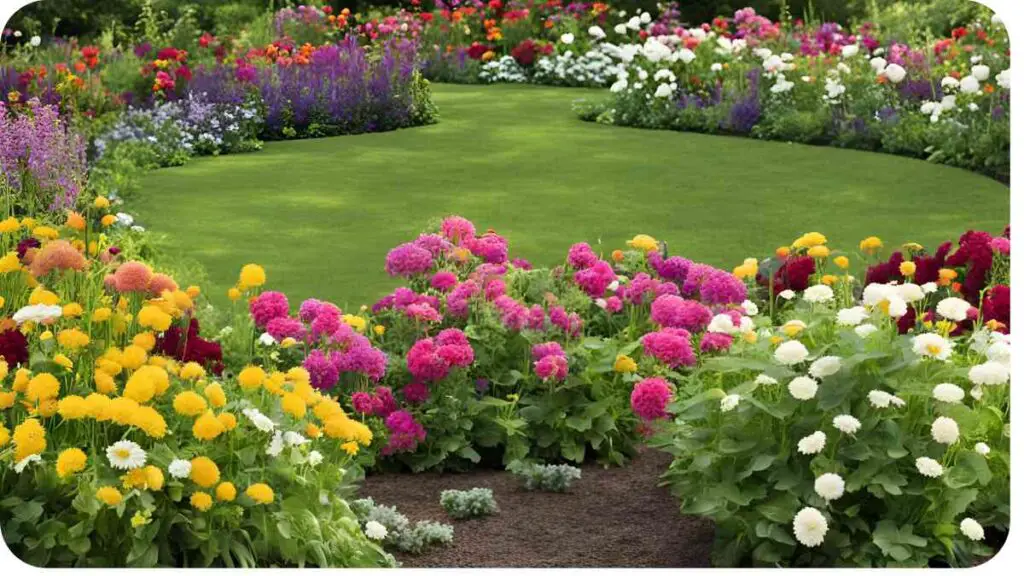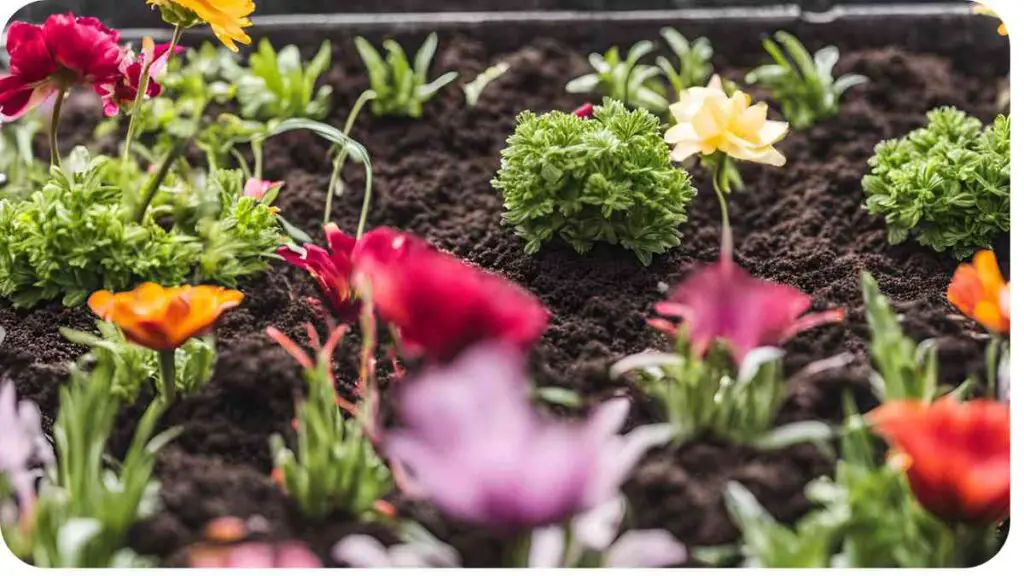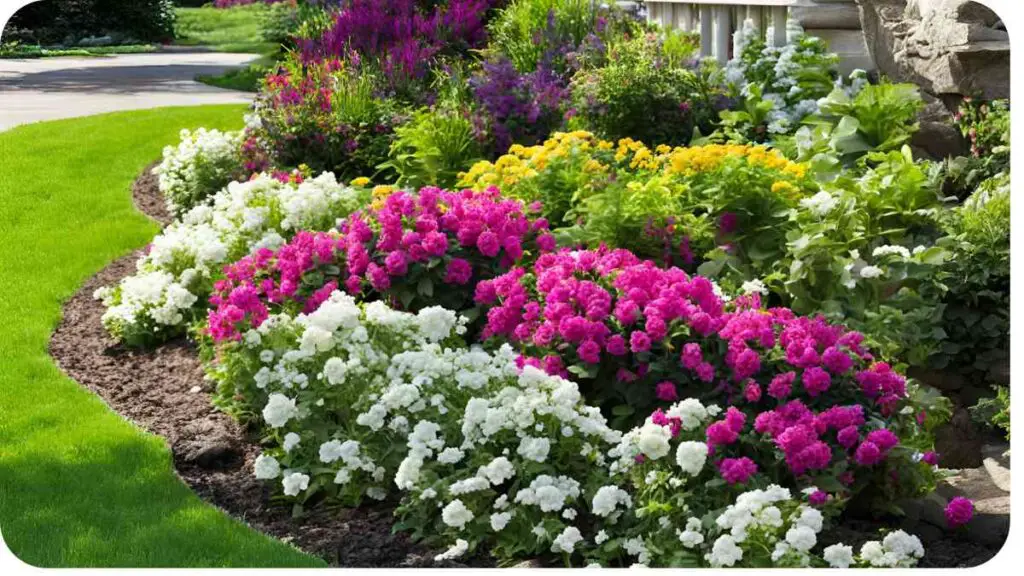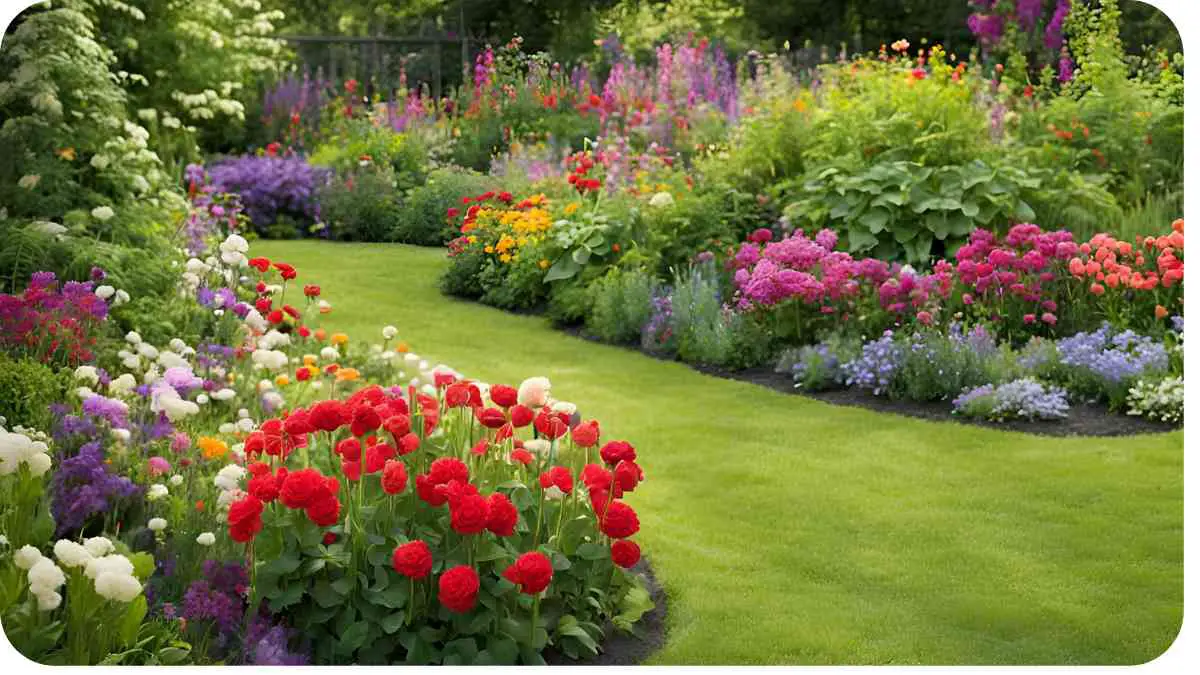Creating a flower garden from scratch is a fulfilling endeavor that allows you to express your creativity while adding beauty and charm to your outdoor space. Whether you’re a seasoned gardener or a complete novice, this guide will walk you through the essential steps to turn your vision into reality.
| Takeaways |
|---|
| 1. Creating a flower garden requires careful planning, including selecting the right location, assessing sunlight and soil conditions, and choosing the appropriate flowers. |
| 2. Proper soil preparation, including soil testing and amending, is essential for providing optimal growing conditions for your flowers. |
| 3. Whether starting from seeds or transplants, proper planting techniques, including spacing and watering, are crucial for the success of your flower garden. |
| 4. Regular maintenance tasks such as mulching, watering, weeding, and pest control are necessary to keep your flower garden healthy and vibrant. |
| 5. Enhancing your flower garden with pathways, borders, and garden décor adds structure, visual interest, and personality to your outdoor space. |
2. Planning Your Flower Garden

Determining the Location
Before you start digging, take some time to assess potential locations for your flower garden. Consider factors such as sunlight exposure, soil quality, and accessibility. Choose a spot that receives ample sunlight for most of the day, as most flowering plants thrive in sunny conditions.
When starting your flower garden, consider Maximizing space with tower and wall gardens to optimize limited areas. Vertical gardening offers creative solutions for compact spaces, allowing you to grow more flowers in less area, enhancing the beauty of your garden.
| Sunlight Exposure | Soil Quality | Accessibility |
|---|---|---|
| South-facing | Loamy | Easy access |
Assessing Sunlight and Soil Conditions
Sunlight is crucial for the growth and blooming of flowers. Spend some time observing your chosen location throughout the day to determine how much sunlight it receives. Ideally, your flower garden should receive at least 6-8 hours of direct sunlight daily. If your chosen spot is shaded for a significant portion of the day, consider selecting shade-tolerant flowers or trimming nearby trees to allow more sunlight to filter through.
In addition to sunlight, soil quality plays a vital role in the success of your flower garden. Conduct a simple soil test to assess its pH level and nutrient content. Most flowering plants prefer slightly acidic to neutral soil with good drainage. You can easily adjust the soil pH and fertility by adding organic matter such as compost, well-rotted manure, or peat moss.
Choosing the Right Flowers
Selecting the right flowers is essential for creating a visually appealing and cohesive garden. Consider factors such as bloom time, color palette, height, and texture when choosing your plants. Aim for a mix of annuals and perennials to ensure continuous blooms throughout the growing season.
Research the specific growing requirements of each flower variety to ensure they are compatible with your garden’s conditions. Some popular choices for beginner flower gardeners include marigolds, zinnias, petunias, and cosmos for annuals, and daylilies, coneflowers, salvia, and lavender for perennials.
Designing Your Garden Layout
Once you’ve chosen your flowers, it’s time to design your garden layout. Consider the overall style and theme you want to achieve, whether it’s a formal, structured garden or a more relaxed, cottage-style vibe. Sketch out your garden design on paper, taking into account factors such as plant heights, bloom times, and color combinations.
Preparing your garden to face various challenges is crucial. Learn effective strategies for building resilience against pests, diseases, and environmental stressors. By fortifying your garden’s defenses, you ensure the success and longevity of your flower garden from the outset.
Experiment with different arrangements until you find a layout that feels balanced and harmonious. Don’t be afraid to get creative with pathways, borders, and focal points to add interest and visual appeal to your garden.
3. Preparing the Soil
Soil Testing
Before planting your flowers, it’s essential to understand the composition of your soil. Conducting a soil test can provide valuable insights into its pH level and nutrient content, allowing you to make informed decisions about soil amendments and fertilization.
You can perform a soil test using a DIY kit or by sending a sample to a professional laboratory. Follow the instructions carefully and collect samples from different areas of your garden for a comprehensive analysis.
Once you have your soil test results, you can determine if any adjustments are needed to optimize soil fertility and pH levels for your chosen flowers.
Amending the Soil
Based on your soil test results, you may need to amend your soil to create the ideal growing conditions for your flowers. Common soil amendments include:
- Organic Matter: Adding compost, well-rotted manure, or leaf mold can improve soil structure, drainage, and fertility.
- pH Adjustments: If your soil is too acidic or alkaline, you can adjust the pH level by adding lime to raise it or sulfur to lower it.
- Nutrient Supplements: Depending on your soil test results, you may need to add specific nutrients such as nitrogen, phosphorus, and potassium to ensure optimal plant growth.
Work the amendments into the soil thoroughly using a garden fork or tiller, ensuring they are evenly distributed throughout the planting area.
4. Planting Your Flowers

Starting from Seeds vs. Transplants
One of the first decisions you’ll need to make when planting your flower garden is whether to start from seeds or transplants. Both options have their advantages and considerations.
Even in dry climates, it’s possible to cultivate lush greenery. Explore techniques for nurturing green in the dry and overcoming gardening challenges specific to desert regions. With proper care and adaptation, you can establish a thriving flower garden regardless of your climate’s aridity.
Starting from Seeds:
- Cost-Effective: Seeds are generally more affordable than transplants, allowing you to experiment with a wide variety of flowers without breaking the bank.
- Greater Selection: Seeds offer a vast selection of flower varieties, including rare and heirloom varieties that may not be available as transplants.
- Sowing Control: Starting from seeds gives you greater control over the planting process, allowing you to time your sowings according to your local climate and growing conditions.
Starting from Transplants:
- Instant Gratification: Transplants provide instant results, allowing you to enjoy blooms sooner than starting from seeds, which require time to germinate and grow.
- Convenience: Transplants are convenient for busy gardeners or those with limited space, as they eliminate the need for seed starting and transplanting.
- Reduced Risk: Transplants are less susceptible to failure from factors such as poor germination or adverse weather conditions, providing a more reliable option for beginner gardeners.
Consider your gardening experience, time constraints, and budget when deciding which option is best for your flower garden.
Proper Plant Spacing
Proper plant spacing is essential for ensuring healthy growth and preventing overcrowding in your flower garden. Each flower variety has specific spacing requirements based on its mature size and growth habits.
Refer to the planting instructions provided on seed packets or plant tags for guidance on spacing recommendations. In general, smaller plants may require spacing of 6-12 inches, while larger varieties may need 12-24 inches or more between plants.
Maintaining adequate spacing allows plants to access sunlight, air circulation, and nutrients, reducing the risk of competition for resources and the spread of diseases.
Planting Techniques
When planting your flowers, follow these simple techniques to ensure success:
- Prepare the Soil: Ensure the planting area is free of weeds and debris, and amend the soil as needed for optimal fertility and drainage.
- Dig Proper Holes: Dig holes that are slightly larger than the root balls of your transplants or deep enough to accommodate the depth of your seeds.
- Handle with Care: Handle delicate seedlings and transplants with care to avoid damaging their roots or stems.
- Plant at the Right Depth: Plant seeds at the depth recommended on the seed packet, and transplant seedlings at the same depth they were growing in their containers.
- Water Thoroughly: After planting, water your flowers thoroughly to help settle the soil around the roots and provide essential moisture for establishment.
Attracting pollinators is essential for a vibrant flower garden. Discover how to create a pollinator paradise in your backyard by providing food, shelter, and habitat for bees, butterflies, and other beneficial insects. Enhance biodiversity and ensure successful pollination for your blooming flowers.
5. Mulching and Watering
Importance of Mulching
Mulching is a crucial step in maintaining a healthy and thriving flower garden. Mulch provides a range of benefits, including:
- Moisture Retention: Mulch helps retain soil moisture by reducing evaporation, ensuring that your flowers have consistent access to water, especially during hot and dry periods.
- Weed Suppression: A layer of mulch helps suppress weed growth by blocking sunlight and preventing weed seeds from germinating, reducing the need for tedious and time-consuming weeding.
- Temperature Regulation: Mulch acts as insulation, regulating soil temperature by keeping it cooler in the summer and warmer in the winter, which is particularly beneficial for shallow-rooted plants.
- Soil Protection: Mulch protects the soil from erosion caused by wind and water, as well as from compaction due to heavy rain or foot traffic.
Choose organic mulches such as shredded bark, straw, or compost, which not only provide these benefits but also gradually decompose, enriching the soil with organic matter and nutrients.
Watering Frequency and Techniques
Proper watering is essential for the health and vitality of your flower garden. While the watering needs of your plants will vary depending on factors such as climate, soil type, and plant species, there are some general guidelines to follow:
- Deep Watering: Water deeply and infrequently to encourage deep root growth and drought tolerance. Aim to water your flowers to a depth of 6-8 inches, ensuring that the entire root zone is thoroughly moistened.
- Morning Watering: Water your garden in the early morning to minimize water loss due to evaporation and reduce the risk of fungal diseases. Avoid watering in the heat of the day, as this can scorch leaves and flowers.
- Mulch Retention: Mulch helps retain soil moisture, reducing the frequency of watering required. Apply a 2-3 inch layer of mulch around your plants, leaving a small space around the stems to prevent moisture-related issues.
- Monitor Soil Moisture: Check the soil moisture regularly by inserting your finger into the soil near the base of your plants. Water when the top inch of soil feels dry to the touch, adjusting the frequency and duration of watering based on weather conditions.
By incorporating mulching and proper watering techniques into your garden maintenance routine, you can help ensure the long-term health and beauty of your flower garden.
6. Maintaining Your Flower Garden

Weeding and Pest Control
Weeding is an essential aspect of flower garden maintenance, as it helps prevent competition for nutrients, water, and sunlight, ensuring the optimal growth of your plants. Regularly inspect your garden for weeds and remove them promptly by hand or using gardening tools such as a hoe or hand cultivator.
Additionally, implement integrated pest management (IPM) strategies to control common garden pests without resorting to harsh chemicals. Encourage natural predators such as ladybugs, lacewings, and birds, which help keep pest populations in check. Consider using companion planting techniques to deter pests, such as planting marigolds to repel aphids or garlic to deter slugs and snails.
Deadheading and Pruning
Deadheading, or removing spent flowers, is an important task that encourages continuous blooming and prevents the formation of seed heads, which can divert energy away from flower production. Simply snip off faded flowers with sharp scissors or pruners, making clean cuts just above a set of healthy leaves or buds.
In addition to deadheading, regular pruning helps maintain the shape, size, and health of your plants. Prune back overgrown or leggy growth to promote bushiness and flowering, and remove any dead, damaged, or diseased branches to prevent the spread of pests and diseases.
Fertilizing
To keep your flowers healthy and vibrant, it’s important to provide them with adequate nutrients throughout the growing season. Incorporate a balanced fertilizer into your garden maintenance routine, applying it according to the specific needs of your plants and soil.
Choose a fertilizer formulation that matches the needs of flowering plants, such as a balanced 10-10-10 or 5-10-5 blend, and follow the manufacturer’s instructions for application rates and frequency. Apply fertilizer evenly around the base of your plants, taking care not to over-fertilize, which can lead to nutrient imbalances and environmental pollution.
Add a touch of creativity to your flower garden with unique planters. Explore innovative ideas for transforming items into creative planters that add charm and personality to your garden space. From upcycled containers to unconventional vessels, let your imagination flourish in your gardening endeavors.
7. Dealing with Common Challenges
Pests and Diseases
Despite your best efforts, your flower garden may still face challenges from pests and diseases. It’s essential to be vigilant and proactive in identifying and addressing these issues to prevent them from causing significant damage to your plants.
Common Garden Pests: Some common garden pests that may affect your flowers include aphids, spider mites, caterpillars, and slugs. Monitor your plants regularly for signs of pest infestation, such as distorted foliage, sticky residue, or chewed leaves. Use insecticidal soap, neem oil, or biological controls such as beneficial nematodes to manage pest populations effectively.
Plant Diseases: Flowering plants are susceptible to various diseases, including powdery mildew, fungal leaf spots, and root rot. Practice good sanitation by removing and disposing of infected plant material promptly to prevent the spread of disease. Provide adequate air circulation and avoid overhead watering to reduce humidity levels, which can create favorable conditions for fungal growth. Consider using fungicides sparingly as a last resort, opting for organic options whenever possible.
Extreme Weather Conditions
Extreme weather conditions such as drought, heatwaves, or heavy rainfall can pose significant challenges for your flower garden. Take proactive measures to protect your plants and minimize damage during adverse weather events.
Drought Management: During periods of drought, ensure that your plants receive sufficient water to maintain their health and vitality. Deep watering, mulching, and applying organic matter to the soil can help retain moisture and reduce water stress on your plants. Consider installing a drip irrigation system or using soaker hoses to deliver water directly to the root zone, minimizing water loss through evaporation.
Heat Stress: High temperatures can cause heat stress in plants, leading to wilting, sunburn, and reduced flowering. Provide shade cloth or temporary shade structures to protect sensitive plants from intense sunlight, especially during the hottest part of the day. Water your garden in the early morning or late evening to avoid heat stress and minimize water loss through evaporation.
Flooding and Waterlogged Soil: Excessive rainfall or poor drainage can result in waterlogged soil, which deprives plant roots of oxygen and promotes root rot. Improve soil drainage by incorporating organic matter such as compost or planting in raised beds to prevent waterlogging. Consider installing drainage systems or redirecting runoff away from your garden to minimize the risk of flooding.
By being proactive and implementing preventive measures, you can effectively manage common challenges and ensure the health and vitality of your flower garden, even in the face of adverse weather conditions.
8. Enhancing Your Garden
Adding Pathways and Borders
Pathways and borders can add structure, visual interest, and functionality to your flower garden, enhancing its overall appeal. Consider incorporating pathways made from materials such as gravel, mulch, or paving stones to create defined walking paths and delineate different garden beds.
Pathways not only provide practical access to different areas of your garden but also serve as design elements that guide visitors through the space. Experiment with different materials, shapes, and patterns to create a unique and inviting garden layout that reflects your personal style.
In addition to pathways, borders can help define garden beds and provide a tidy edge to your planting areas. Use materials such as bricks, stones, or decorative edging to create borders that complement the style and theme of your garden. Borders not only add visual appeal but also help contain spreading plants and prevent grass and weeds from encroaching on your flower beds.
Incorporating Garden Décor
Garden décor adds personality and charm to your flower garden, transforming it into a delightful outdoor sanctuary. From whimsical statues and sculptures to elegant fountains and birdbaths, there are countless options to choose from to enhance your garden’s ambiance.
Consider adding focal points such as trellises, arbors, or pergolas to create vertical interest and provide support for climbing plants such as roses, clematis, or morning glories. Install bird feeders, birdhouses, and butterfly feeders to attract wildlife and create a lively and dynamic garden ecosystem.
Don’t forget to add comfortable seating areas where you can relax and enjoy the beauty of your flower garden. Whether it’s a cozy bench nestled among blooming flowers or a shaded patio with comfortable chairs and tables, create inviting spaces where you can unwind and connect with nature.
Conclusion
Creating a flower garden from scratch is a rewarding and fulfilling experience that allows you to unleash your creativity and express your passion for gardening. By following the steps outlined in this guide, from planning and planting to maintenance and enhancement, you can create a beautiful and thriving garden that brings joy and inspiration year after year.
Remember to adapt and experiment with different techniques and strategies to find what works best for your unique garden space and personal preferences. With patience, dedication, and a little bit of imagination, you can create a flower garden that truly reflects your style and personality, bringing beauty and tranquility to your outdoor oasis.
Further Reading
- Martha Stewart: How to Make a Flower Bed
- Learn from Martha Stewart’s expert tips and advice on how to create a stunning flower bed that adds beauty and charm to your outdoor space.
- The Old Farmer’s Almanac: How to Start a Flower Garden
- Discover the timeless wisdom and practical guidance of The Old Farmer’s Almanac on starting and maintaining a flourishing flower garden, from planning to planting.
- Better Homes & Gardens: How to Build a Flower Bed
- Explore Better Homes & Gardens’ comprehensive guide to building a flower bed, including step-by-step instructions, design ideas, and expert tips for success.
FAQs
How do I choose the right location for my flower garden?
- When selecting a location for your flower garden, consider factors such as sunlight exposure, soil quality, and accessibility. Choose a spot that receives ample sunlight for most of the day and has well-draining soil.
What are some popular flowers for beginners?
- Some popular flowers for beginner gardeners include marigolds, zinnias, petunias, and cosmos for annuals, and daylilies, coneflowers, salvia, and lavender for perennials.
How often should I water my flower garden?
- Watering frequency depends on factors such as climate, soil type, and plant species. In general, aim to water your flower garden deeply and infrequently, ensuring that the soil is evenly moist but not waterlogged.
How can I prevent weeds in my flower garden?
- To prevent weeds, mulch your flower beds with organic materials such as shredded bark or compost to suppress weed growth and retain soil moisture. Additionally, practice regular weeding to remove any emerging weeds before they become established.
How do I deadhead my flowers?
- Deadheading involves removing spent flowers to encourage continuous blooming and prevent the formation of seed heads. Simply snip off faded flowers with sharp scissors or pruners, making clean cuts just above a set of healthy leaves or buds.

For 15 years, Hellen James has worked in the gardening industry as an expert and landscape designer. During her career, she has worked for a variety of businesses that specialize in landscaping and gardening from small firms to large corporations.

